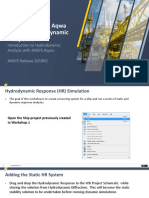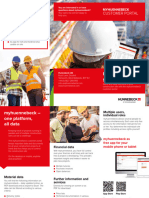Mech BSN 2019R3 EN WS06.1
Mech BSN 2019R3 EN WS06.1
Uploaded by
cananbudak540Copyright:
Available Formats
Mech BSN 2019R3 EN WS06.1
Mech BSN 2019R3 EN WS06.1
Uploaded by
cananbudak540Original Title
Copyright
Available Formats
Share this document
Did you find this document useful?
Is this content inappropriate?
Copyright:
Available Formats
Mech BSN 2019R3 EN WS06.1
Mech BSN 2019R3 EN WS06.1
Uploaded by
cananbudak540Copyright:
Available Formats
Workshop 06.
1:
Linear Perturbation
ANSYS Mechanical Basic Structural
Nonlinearities
2019 R3
All rights reserved. For personal use only.
Unauthorized use, distribution, or duplication is prohibited.
1 1 © 2019 ANSYS, Inc.
Introduction
Goal
• Show how calculation of the critical load is affected by the nature of the
static pre-stress analysis
2 © 2019 ANSYS, Inc.
Model Description
Model Description
• 5 bodies, MPC contact between all
• Meshed with 3D shell elements
• Linear elastic material
3 © 2019 ANSYS, Inc.
Project Startup
Steps to Follow:
• Start an ANSYS Workbench session.
• Use File > Open… to browse for existing file
“SNLWS06.1-linear-perturbation.wbpz”
File name: “WS06.1-linear-perturbation”
Save as type: Project Files (*.wbpj)
4 © 2019 ANSYS, Inc.
Project Schematic
The Project Schematic should look like this
• From this schematic, you can see that the
Engineering Data, Geometry, and Model (mesh)
have already been defined.
• It remains to set up and run the FE models in
Mechanical.
• Double-click on Model cell A4 to launch
Mechanical.
• Verify that the units are set to
Metric (mm, t, N, …).
5 © 2019 ANSYS, Inc.
Model Description
Familiarize yourself with the model’s geometry, mesh, contact, and boundary
conditions.
6 © 2019 ANSYS, Inc.
Model Description
Verify that the model is linear:
Large Deflection set to “Off” Bonded contact with MPC Linear material properties only Confirmation: In Analysis Setting
formulation Details, Nonlinear Solution = No
Solve both analysis systems:
7 © 2019 ANSYS, Inc.
Postprocessing
Review results from the Static Structural (pre-stress) analysis:
8 © 2019 ANSYS, Inc.
Postprocessing
Review results from the Eigenvalue Buckling analysis:
Modes 1 and 2 have the same load multiplier—they are
symmetric modes (orthogonal principal directions).
The Mode 1 load multiplier (3.437) can be used to calculate
the critical load:
Buckling Load = ForceApplied *
Buckling Load = 500,000 N * 3.437 = 1.718 MN = 175.2 tf
9 © 2019 ANSYS, Inc.
Project Schematic
Return to the Project Schematic and
duplicate the Static Structural analysis:
• RMB > Model cell (A4) > Duplicate
• Rename the new analysis system to
“Nonlinear Model”
10 © 2019 ANSYS, Inc.
Project Schematic
Drag an Eigenvalue Buckling analysis system from the Toolbox onto the
Solution cell of Analysis System C and rename the new analysis system to
“Eigenvalue - Nonlinear Model”
Open a new Mechanical session by double-clicking Model cell C4
11 © 2019 ANSYS, Inc.
Analysis Settings
Change/confirm the following Analysis Settings
in the nonlinear Static Structural analysis:
• Auto Time Stepping = On
• Initial Substeps = 2
• Minium Substeps = 1
• Maximum Substeps = 10
• Large Deflection = On
12 © 2019 ANSYS, Inc.
Solution
Execute solution of the Static
Structural analysis.
Select the Solution Information
branch of the Static Structural
analysis and set the Solution
Output Detail to Force
Convergence. The nonlinear
static model converges after 3
iterations.
13 © 2019 ANSYS, Inc.
Postprocessing
Review results from the nonlinear pre-stress analysis and compare them with
the results from the linear pre-stress analysis:
Deformation and stress results are similar. Thus, the stiffness of the two
models as calculated by the ANSYS solver are similar and the results of the
follow-on eigenvalue buckling analysis should also be similar.
14 © 2019 ANSYS, Inc.
Nonlinear-Based Eigenvalue Buckling
Perform the follow-on eigenvalue buckling analysis:
• Ask for 4 modes to be calculated
• Confirm that “keep pre-stress load-pattern” is set to
“Yes” (this will use the load pattern from the static
analysis)
• Solve
• Select the Solution branch for the Eigenvalue Buckling analysis
• In the Graph view,
RMB > Select All
15 © 2019 ANSYS, Inc.
Nonlinear-Based Eigenvalue Buckling
RMB > Create Mode Shape Results RMB > Evaluate All Results
Observe that Modes 1 and 2 are still symmetric:
16 © 2019 ANSYS, Inc.
Nonlinear-Based Eigenvalue Buckling
Compare the nonlinear-based and linear-based Load Multipliers:
Nonlinear-Based Linear-Based
The Load Multipliers are different, but remember that the critical load
calculation is also different, as it depends on the nature of the pre-stress
analysis:
Nonlinear-Based Linear-Based
Buckling Load = ForceRestart + ForcePerturbation * Buckling Load = ForceApplied *
Buckling Load = 500,000 N + 500,000 N * 2.443 Buckling Load = 500,000 N * 3.437
= 1.721 MN = 175.5 tf = 1.718 MN = 175.2 tf
As expected, the critical load is similar for both cases.
17 © 2019 ANSYS, Inc.
Go Further!
Change the contact region Formulations to Pure Penalty, set Large
Deflection to Off, and verify that this formula applies even if the pre-stress
model is linear:
Buckling Load = ForceRestart + ForcePerturbation *
Introduce an additional nonlinearity (e.g., an elastic-plastic material) and
assess its effect on the critical load.
18 © 2019 ANSYS, Inc.
Workshop 06.1:
Linear Perturbation
END
1919 © 2019 ANSYS, Inc.
You might also like
- Mechanical Intro 17.0 M08 Eigenvalue Buckling and SubmodelingNo ratings yetMechanical Intro 17.0 M08 Eigenvalue Buckling and Submodeling34 pages
- Workshop 03.1: Aqwa Basics - Hydrodynamic Response100% (1)Workshop 03.1: Aqwa Basics - Hydrodynamic Response37 pages
- Workshop 04.1: Metal Plasticity: ANSYS Mechanical Basic Structural NonlinearitiesNo ratings yetWorkshop 04.1: Metal Plasticity: ANSYS Mechanical Basic Structural Nonlinearities28 pages
- Workshop 03.1: Linear Structural Analysis: Introduction To ANSYS MechanicalNo ratings yetWorkshop 03.1: Linear Structural Analysis: Introduction To ANSYS Mechanical24 pages
- Mechanical Intro 17.0 M03 Structural Analysis PDFNo ratings yetMechanical Intro 17.0 M03 Structural Analysis PDF49 pages
- Mech Intro 18.0 WS03.2 Workshop Instructions Beam ConnectionsNo ratings yetMech Intro 18.0 WS03.2 Workshop Instructions Beam Connections19 pages
- Mech Intro 18.0 WS06.3 Workshop Instructions Remote Boundary ConditionsNo ratings yetMech Intro 18.0 WS06.3 Workshop Instructions Remote Boundary Conditions12 pages
- Mechanical Intro 15.0 AppendixA BucklingNo ratings yetMechanical Intro 15.0 AppendixA Buckling34 pages
- Mechanical Intro 17.0 WS04.1 Mesh EvaluationNo ratings yetMechanical Intro 17.0 WS04.1 Mesh Evaluation20 pages
- Analysis and Design Method of Structures Using Tension-Only ElementsNo ratings yetAnalysis and Design Method of Structures Using Tension-Only Elements15 pages
- Workshop 03.2: Beam Connections: Introduction To ANSYS MechanicalNo ratings yetWorkshop 03.2: Beam Connections: Introduction To ANSYS Mechanical19 pages
- Stress Linearization: 1 © 2015 ANSYS, Inc. January 23, 2017No ratings yetStress Linearization: 1 © 2015 ANSYS, Inc. January 23, 201713 pages
- Module 04: Postprocessing, Validation, CAD, and Parameters: Introduction To ANSYS MechanicalNo ratings yetModule 04: Postprocessing, Validation, CAD, and Parameters: Introduction To ANSYS Mechanical66 pages
- Mechanical Intro 15.0 AppendixA BucklingNo ratings yetMechanical Intro 15.0 AppendixA Buckling34 pages
- Additive Manufacturing Applications in ANSYS Mechanical R19.1 - Presentation100% (3)Additive Manufacturing Applications in ANSYS Mechanical R19.1 - Presentation63 pages
- Manual de Diseño de Elemento Metálicos Según SFD-AISC-360-05No ratings yetManual de Diseño de Elemento Metálicos Según SFD-AISC-360-05209 pages
- Department of Automobile & Mechanical Engineering: System Design and SimulationNo ratings yetDepartment of Automobile & Mechanical Engineering: System Design and Simulation12 pages
- Mesh-Intro 19R2 WS5.4 CFD Workshop Instructions ManifoldNo ratings yetMesh-Intro 19R2 WS5.4 CFD Workshop Instructions Manifold16 pages
- Detailed Report On Performing Fatigue Analysis Using ANSYSNo ratings yetDetailed Report On Performing Fatigue Analysis Using ANSYS5 pages
- Mechanical Intro 17.0 WS01.1 Mechanical BasicsNo ratings yetMechanical Intro 17.0 WS01.1 Mechanical Basics26 pages
- ANSYS Workbench 2019 R2: A Tutorial Approach, 3rd EditionFrom EverandANSYS Workbench 2019 R2: A Tutorial Approach, 3rd EditionNo ratings yet
- 2022 - McCarthy - Bathy - Automated High-Resolution Satellite-Derived Coastal Bathymetry MappingNo ratings yet2022 - McCarthy - Bathy - Automated High-Resolution Satellite-Derived Coastal Bathymetry Mapping8 pages
- PDF Imagining Xerxes Ancient Perspectives On A Persian King 1. Publ Edition Emma Bridges Download100% (8)PDF Imagining Xerxes Ancient Perspectives On A Persian King 1. Publ Edition Emma Bridges Download44 pages
- North Korean Politics and Society: Instructor I's ProfileNo ratings yetNorth Korean Politics and Society: Instructor I's Profile7 pages
- Promars: Owner's Manual PLUG-OUT Software SynthesizerNo ratings yetPromars: Owner's Manual PLUG-OUT Software Synthesizer10 pages
- Modeling and Path Simulation of An Autonomous Tomato Picking RobotNo ratings yetModeling and Path Simulation of An Autonomous Tomato Picking Robot12 pages
- Green Buildings, Organizational Success, and Occupant Productivity (Heerwagen, 2000)No ratings yetGreen Buildings, Organizational Success, and Occupant Productivity (Heerwagen, 2000)21 pages
- Presenting Analysis, Context and Criticism On Commonly Studied NovelsNo ratings yetPresenting Analysis, Context and Criticism On Commonly Studied Novels26 pages
- Mechanical Intro 17.0 M08 Eigenvalue Buckling and SubmodelingMechanical Intro 17.0 M08 Eigenvalue Buckling and Submodeling
- Workshop 03.1: Aqwa Basics - Hydrodynamic ResponseWorkshop 03.1: Aqwa Basics - Hydrodynamic Response
- Workshop 04.1: Metal Plasticity: ANSYS Mechanical Basic Structural NonlinearitiesWorkshop 04.1: Metal Plasticity: ANSYS Mechanical Basic Structural Nonlinearities
- Workshop 03.1: Linear Structural Analysis: Introduction To ANSYS MechanicalWorkshop 03.1: Linear Structural Analysis: Introduction To ANSYS Mechanical
- Mech Intro 18.0 WS03.2 Workshop Instructions Beam ConnectionsMech Intro 18.0 WS03.2 Workshop Instructions Beam Connections
- Mech Intro 18.0 WS06.3 Workshop Instructions Remote Boundary ConditionsMech Intro 18.0 WS06.3 Workshop Instructions Remote Boundary Conditions
- Analysis and Design Method of Structures Using Tension-Only ElementsAnalysis and Design Method of Structures Using Tension-Only Elements
- Workshop 03.2: Beam Connections: Introduction To ANSYS MechanicalWorkshop 03.2: Beam Connections: Introduction To ANSYS Mechanical
- Stress Linearization: 1 © 2015 ANSYS, Inc. January 23, 2017Stress Linearization: 1 © 2015 ANSYS, Inc. January 23, 2017
- Module 04: Postprocessing, Validation, CAD, and Parameters: Introduction To ANSYS MechanicalModule 04: Postprocessing, Validation, CAD, and Parameters: Introduction To ANSYS Mechanical
- Additive Manufacturing Applications in ANSYS Mechanical R19.1 - PresentationAdditive Manufacturing Applications in ANSYS Mechanical R19.1 - Presentation
- Manual de Diseño de Elemento Metálicos Según SFD-AISC-360-05Manual de Diseño de Elemento Metálicos Según SFD-AISC-360-05
- Department of Automobile & Mechanical Engineering: System Design and SimulationDepartment of Automobile & Mechanical Engineering: System Design and Simulation
- Mesh-Intro 19R2 WS5.4 CFD Workshop Instructions ManifoldMesh-Intro 19R2 WS5.4 CFD Workshop Instructions Manifold
- Detailed Report On Performing Fatigue Analysis Using ANSYSDetailed Report On Performing Fatigue Analysis Using ANSYS
- Modeling and Dimensioning of Structures: An IntroductionFrom EverandModeling and Dimensioning of Structures: An Introduction
- ANSYS Workbench 2019 R2: A Tutorial Approach, 3rd EditionFrom EverandANSYS Workbench 2019 R2: A Tutorial Approach, 3rd Edition
- 2022 - McCarthy - Bathy - Automated High-Resolution Satellite-Derived Coastal Bathymetry Mapping2022 - McCarthy - Bathy - Automated High-Resolution Satellite-Derived Coastal Bathymetry Mapping
- PDF Imagining Xerxes Ancient Perspectives On A Persian King 1. Publ Edition Emma Bridges DownloadPDF Imagining Xerxes Ancient Perspectives On A Persian King 1. Publ Edition Emma Bridges Download
- North Korean Politics and Society: Instructor I's ProfileNorth Korean Politics and Society: Instructor I's Profile
- Promars: Owner's Manual PLUG-OUT Software SynthesizerPromars: Owner's Manual PLUG-OUT Software Synthesizer
- Modeling and Path Simulation of An Autonomous Tomato Picking RobotModeling and Path Simulation of An Autonomous Tomato Picking Robot
- Green Buildings, Organizational Success, and Occupant Productivity (Heerwagen, 2000)Green Buildings, Organizational Success, and Occupant Productivity (Heerwagen, 2000)
- Presenting Analysis, Context and Criticism On Commonly Studied NovelsPresenting Analysis, Context and Criticism On Commonly Studied Novels

























































































